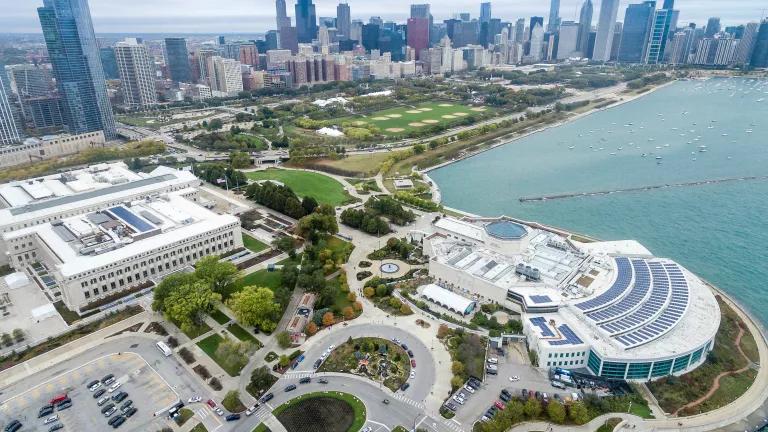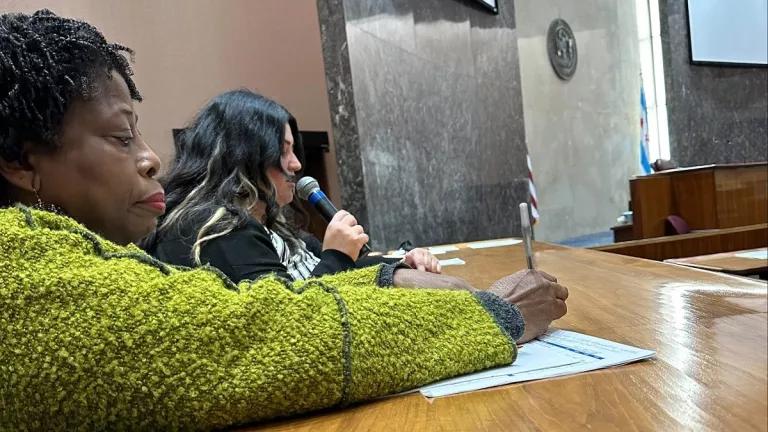Cities Are Stepping Up to Do What's Right on Climate—and Winning

This week, mayors from across North America met in Chicago to reaffirm their commitment to climate action.
In the fight against catastrophic climate change, the friends of fossil fuels may be getting the ink, but the good guys are actually winning. That’s because, despite the lack of leadership in Washington, leaders of vision at the state, local, and city levels understand the stakes—for our families, our communities, and our country—in taking real action to fight climate change.
In a rare public appearance, former President Obama drove the point home Tuesday. During his time in the White House, he said, climate considerations were viewed as central to U.S. interests, from national security and economic policy to global development and our children’s future.
“There was not one aspect of policy that we were concerned about that was not touched, profoundly, by this issue,” Obama told a group of mayors pressing progressive clean energy and climate policies in their cities. “But this, this is something we can do something about. And I’m hoping, as a consequence of you seeing meaningful impacts in your own cities, and you realizing that you’re part of a broader movement, that that inspires you to bolder and bolder work, and that, in turn, I think, can inspire a country, and that will inspire the world.”
Obama made the remarks in Chicago, where Mayor Rahm Emanuel hosted several dozen of his U.S., Canadian, and Mexican counterparts for a climate and clean energy summit. Representatives from some 50 cities signed their own Chicago Charter, pledging to advance real action to cut the carbon pollution that’s driving climate change.
Even as President Trump and his toxic minions put the interests of oil, gas, and coal ahead of our children’s future, there’s real action afoot to fight climate change at the state and city levels.
That’s important. The keys to averting the worst impacts of climate change are to reduce the carbon pollution from burning fossil fuels and to find cleaner, smarter ways to power our future.
To do that, we need visionary leadership in our cities, because roughly two-thirds of the global carbon footprint is tied to urban activity. And that’s exactly where we’re moving forward.
Chicago is one of more than 7,400 cities stepping up to do what’s right. Together, they represent nearly 700 million people. Gathered around the Global Covenant of Mayors for Climate & Energy, the leaders of these urban areas have pledged to improve the energy efficiency of their buildings and transportation systems; to incorporate sustainable infrastructure in future planning and design; and to get more clean power from the wind and sun.
It’s a winning formula that’s already paying off in Chicago and across the country. U.S. carbon emissions have fallen 14 percent since 2005 while our economy has grown more than 19 percent (adjusting for inflation). And in Chicago, between 2005 and 2015, while jobs grew 7 percent, the city cut its carbon footprint 11 percent, largely by reducing the amount of energy required to keep buildings comfortable and well lit.
Chicago received national recognition this year from the U.S. Environmental Protection Agency for its groundbreaking Energy Benchmarking Ordinance. The ordinance requires owners of large commercial, industrial, and residential buildings to monitor and report energy use and provides the basis for rating specific buildings based on their energy efficiency. The data is vital to understanding how energy is used in Chicago and identifying opportunities to do more with less waste.
Emanuel has set a goal of powering all of Chicago’s public buildings―which account for about 8 percent of the city’s electricity use―with renewable energy by 2025. By that year, he aims to have cut the Windy City’s carbon emission at least 26 percent below 2005 levels, in line with the national carbon reduction target President Obama set at the 2015 Paris climate summit. Building on that kind of progress is the purpose of this week’s North American Climate Summit, held in Chicago in concert with the Global Covenant of Mayors for Climate & Energy.
We have a duty to protect our children against the growing dangers of rising seas, widening deserts, mass extinction, withering drought, melting glaciers, raging floods, and the kind of ocean warming that’s killing the Great Barrier Reef. Not to mention the re-reversal of the Chicago River and the super-soaker storms in the Northeast that send sewage into people’s basements.
We also have an opportunity. Over the next two decades or so, investment in clean energy is set to top $7 trillion worldwide. We need to prepare American workers for success in that global marketplace, and that begins by advancing clean energy in American cities like Chicago.
Trump, of course, is working to withdraw U.S. participation from the landmark agreement reached in Paris, where 197 countries pledged to reduce carbon pollution by shifting away from fossil fuels. And he is doing real harm. He’s trying to kill the Clean Power Plan, a commonsense rule to clean up the dirty power plants that account for nearly 40 percent of the nation’s carbon footprint. He’s filling key energy and environmental policy posts with fossil fuel apologists and climate change deniers. And he’s turning his back on the rapidly growing clean energy economy―and the three million jobs it supports.
That’s not a strategy for making America great. It’s a strategy to put polluter profits first and to put the rest of us at risk.
Fortunately, not everyone’s on board. In cities like Chicago and across the country, from Albany to Seattle, from Miami to San Diego, visionary leaders are keeping their eyes on the prize. There’s a great contest playing out that pits fossil fuel profits against our children’s future. At the gates of our nation’s greatest cities, the right side in that fight is coming out on top.



